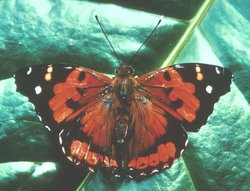Difference between a butterfly and a moth
|
|
The differences between butterflies and moths are subtle, but there are a few ways to distinguish these closely-related insects of the order Lepidoptera. The issue is complicated because the designations "butterfly" and "moth," while indispensable for laypersons and even for scientists, are popular, not scientific, terms. That is, "butterfly" and "moth" are not natural classifications based on differences in morphology or behavior.
Of course, no rule is perfect, but as a general rule the following conditions apply; exceptions are so few and far between that for almost all purposes the terms "butterfly" and "moth" are acceptable. (There are, however, many brightly-colored, day-flying species of moths, for example, and there is even one species of butterfly, Pseudopontia paradoxa from the forests of central Africa, whose thread-like antennae lack the distinctive clubbed ends that identify butterflies.)
Rules
- The most obvious difference is in the feelers, or antennae. A butterfly has a thin straight pair of antennae which ends in a small club, while moths usually have large feathered antennae in the males that help them to sense female pheremones in the air and to steer themselves when they fly in the darkness and thin, straight, unclubbed antennae in the females. Not all moths have the feathering on their antennae, but they all lack the clubbed end of a butterfly. This distinction is the basis for the non-standard taxonomy distinction between Lepidoptera "division" Rhopalocera ("clubbed antenae", the butterflies) and "division" Heterocera ("variegated antennae", the moths).
- The large majority of moths are nocturnal or crepuscular (active at dawn and dusk), while there are few nocturnal butterflies.
- Another major difference is in their pupa or metamorphosis stage when they change from caterpillar to adult insect. A moth normally spins a cocoon around its pupa to protect and conceal itself, while butterflies metamorphose inside a hardened shell called a chrysalis. Hawk moths, however, metamorphose inside a chrysalis, typically undergound.
- Many, but not all, butterflies have bright colorful patterns on their wings. Nocturnal moths' wings are usually plain brown/grey/white/black, often with obscuring patterns of zigzags or swirls, to help camouflage them while they are resting in the daytime. However day-flying moths are often brightly-colored, particularly if they are toxic.
- Moths rest with their wings spread out to their sides. Butterflies frequently fold their wings above their backs when they are perched. Some species, like the skippers, may hold their wings either flat, or folded, or even in-between (the so-called "jet plane" position) when perched.
- Moths tend to have very fat hairy or furry appearing bodies, while butterflies are slighter and smoother.
- Moths' fore and hindwings are connected, while those of butterflies can move independently. This gives the latter a more graceful flight.
Missing image
Polythemusmoth.jpg
Polythemus Moth
Polythemus moth - note the feathered antennae and fat furry body
A Kamehameha butterfly - not the best example in the world, but note the clubbed antennae and slender body
Missing image
Monarchbutterflysm.jpg
Monarch Butterfly
A Monarch butterfly demonstrating a common butterfly resting positionnl:Verschil tussen dagvlinder en nachtvlinder

